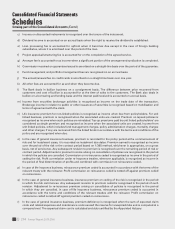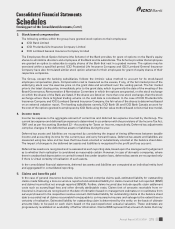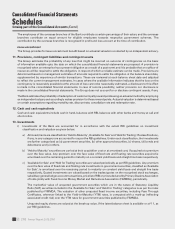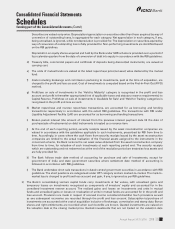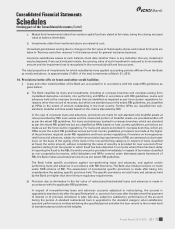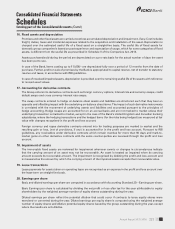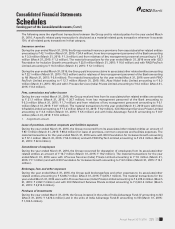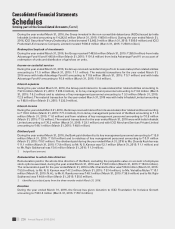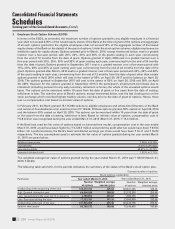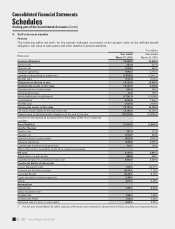ICICI Bank 2016 Annual Report Download - page 225
Download and view the complete annual report
Please find page 225 of the 2016 ICICI Bank annual report below. You can navigate through the pages in the report by either clicking on the pages listed below, or by using the keyword search tool below to find specific information within the annual report.
Annual Report 2015-2016 223
Schedules
forming part of the Consolidated Accounts (Contd.)
Consolidated Financial Statements
16. Fixed assets and depreciation
Premises and other xed assets are carried at cost less accumulated depreciation and impairment, if any. Cost includes
freight, duties, taxes and incidental expenses related to the acquisition and installation of the asset. Depreciation is
charged over the estimated useful life of a xed asset on a straight-line basis. The useful life of xed assets for
domestic group companies is based on past experience and expectation of usage, which for some categories of xed
assets, is different from the useful life as prescribed in Schedule II of the Companies Act, 2013.
Assets purchased/sold during the period are depreciated on a pro-rata basis for the actual number of days the asset
has been put to use.
In case of the Bank, items costing up to ` 5,000/- are depreciated fully over a period of 12 months from the date of
purchase. Further, prot on sale of premises by the Bank is appropriated to capital reserve, net of transfer to statutory
reserve and taxes, in accordance with RBI guidelines.
In case of revalued/impaired assets, depreciation is provided over the remaining useful life of the assets with reference
to revised asset values.
17. Accounting for derivative contracts
The Group enters into derivative contracts such as foreign currency options, interest rate and currency swaps, credit
default swaps and cross currency interest rate swaps.
The swap contracts entered to hedge on-balance sheet assets and liabilities are structured such that they bear an
opposite and offsetting impact with the underlying on-balance sheet items. The impact of such derivative instruments
is co-related with the movement of underlying assets and liabilities and accounted pursuant to the principles of
hedge accounting. Hedge swaps are accounted for on an accrual basis and are not marked to market unless their
underlying transaction is marked to market, except in the case of the Bank’s United Kingdom and Canadian banking
subsidiaries, where the hedging transactions and the hedged items (for the risks being hedged) are measured at fair
value with changes recognised in the prot and loss account.
Foreign currency and rupee derivative contracts entered into for trading purposes are marked to market and the
resulting gain or loss, (net of provisions, if any) is accounted for in the prot and loss account. Pursuant to RBI
guidelines, any receivables under derivative contracts which remain overdue for more than 90 days and mark-to-
market gains on other derivative contracts with the same counter-parties are reversed through the prot and loss
account.
18. Impairment of assets
The immovable xed assets are reviewed for impairment whenever events or changes in circumstances indicate
that the carrying amount of an asset may not be recoverable. An asset is treated as impaired when its carrying
amount exceeds its recoverable amount. The impairment is recognised by debiting the prot and loss account and
is measured as the amount by which the carrying amount of the impaired assets exceeds their recoverable value.
19. Lease transactions
Lease payments for assets taken on operating lease are recognised as an expense in the prot and loss account over
the lease term on straight line basis.
20. Earnings per share
Basic and diluted earnings per share are computed in accordance with Accounting Standard 20 – Earnings per share.
Basic Earnings per share is calculated by dividing the net prot or loss after tax for the year attributable to equity
shareholders by the weighted average number of equity shares outstanding during the year.
Diluted earnings per share reect the potential dilution that could occur if contracts to issue equity shares were
exercised or converted during the year. Diluted earnings per equity share is computed using the weighted average
number of equity shares and dilutive potential equity shares issued by the group outstanding during the year, except
where the results are anti-dilutive.



